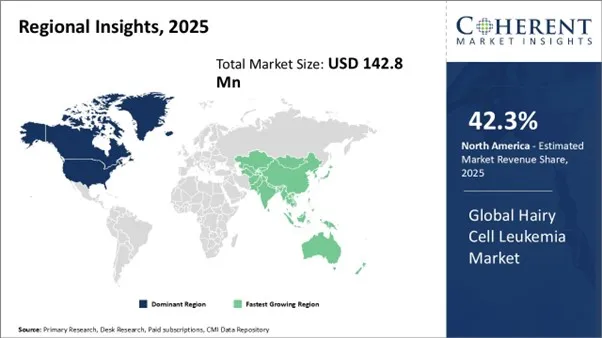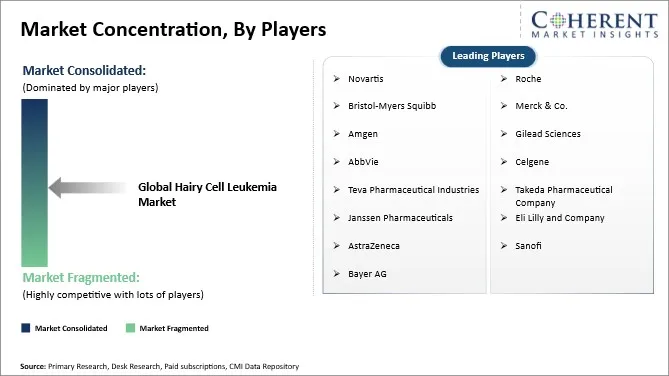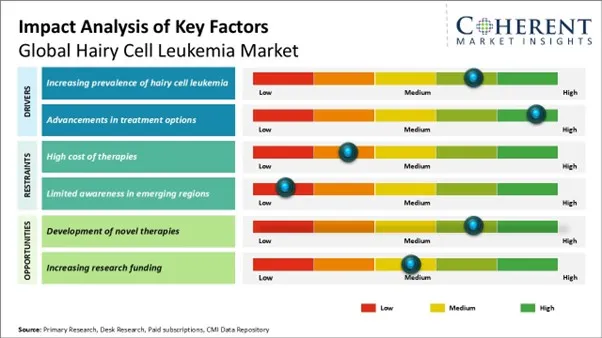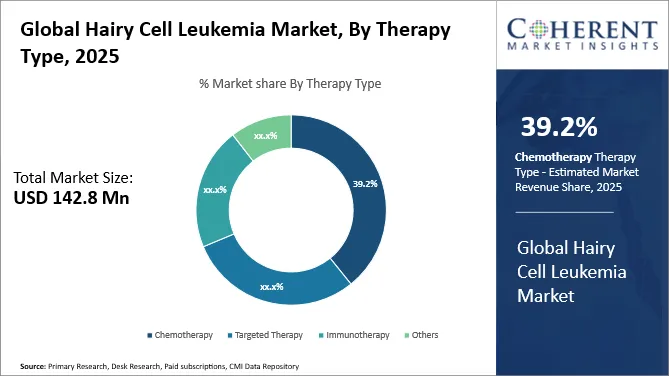Global Hairy Cell Leukemia Market Size and Forecast – 2025 to 2032
The Global Hairy Cell Leukemia Market is estimated to be valued at USD 142.8 million in 2025 and is expected to reach USD 223.3 million by 2032, exhibiting a compound annual growth rate (CAGR) of 6.6% from 2025 to 2032. This growth is driven by factors such as increasing incidence of hairy cell leukemia, advancements in diagnostic techniques, and the development of novel targeted therapies.
Key Takeaways of the Global Hairy Cell Leukemia Market:
- By therapy type, chemotherapy is expected to hold the largest market share at 39. 2% in 2025.
- In terms of route of administration, the oral segment is expected to account for the highest share at 54. 3% in 2025.
- Based on age group, the adult segment is expected to lead the global hairy cell leukemia market with a projected share of 36. 4% in 2025.
- North America is expected to lead the market, holding a share of 42. 3% in 2025. Asia Pacific is anticipated to be the fastest-growing region, with a market share of 36.2% in 2025.
Market Overview:
The market trend for hairy cell leukemia is characterized by a focus on personalized medicine and the adoption of targeted therapies. Pharmaceutical companies are investing in the development of novel drugs that specifically target the genetic mutations associated with hairy cell leukemia. Additionally, there is a growing emphasis on improving patient outcomes through early diagnosis and effective disease management. Increasing collaboration between research institutions, healthcare providers, and industry players are expected to further drive innovation and growth in the hairy cell leukemia market.
Currents Events and their Impact
|
Current Events |
Description and its impact |
|
Technological Advancements in Treatment |
|
|
Rising Demand for Personalized Medicine in Oncology |
|
Uncover macros and micros vetted on 75+ parameters: Get instant access to report
Hairy Cell Leukemia Market Insights, By Therapy Type – Chemotherapy Segment Dominates Due to Proven Efficacy and Durable Remissions
In terms of therapy type, the chemotherapy segment is expected to contribute the highest share of the market with 39.2% in 2025 owing to its long-standing efficacy in treating hairy cell leukemia. Chemotherapeutic agents, such as Cladribine and Pentostatin, have been the mainstay of hairy cell leukemia treatment for decades. These purine analogs work by targeting and destroying the abnormal leukemic cells, leading to high response rates and durable remissions in most patients.
The effectiveness of Cladribine, in particular, has been well-documented in clinical studies. A single course of Cladribine has been shown to induce complete remissions in a significant proportion of patients, with many remaining disease-free for years. The convenience of a single treatment course and the relatively low toxicity profile compared to other chemotherapeutic agents have further contributed to its widespread use.
Hairy Cell Leukemia Market Insights, By Route of Administration – Oral Segment Leads Owing to Convenience, Home-based Treatment, and Compliance
In terms of route of administration, the oral segment is expected to contribute the highest share of the global hairy cell leukemia market with 54.3% in 2025. The preference for oral medications can be attributed to several factors, including patient convenience, ease of administration, and improved treatment compliance.
Oral chemotherapeutic agents, such as Cladribine, have revolutionized the treatment of hairy cell leukemia by offering patients the option to receive their therapy in the comfort of their own homes. This eliminates the need for frequent hospital visits and extended stays, which can be burdensome for both patients and their caregivers. The convenience of oral administration has been shown to improve patients' quality of life and reduce treatment-related stress.
Moreover, oral medications are often associated with better patient compliance compared to parenteral routes of administration. Patients are more likely to adhere to their prescribed treatment regimen when they can take their medication orally, as it fits more easily into their daily routine. Improved compliance can lead to better treatment outcomes and reduced risk of relapse.
Hairy Cell Leukemia Market Insights, By Age Group – Adult Segment Dominates Due to Higher Disease Incidence in Middle-Aged and Older Population
In terms of age group, the adult segment is expected to contribute the highest share of the global hairy cell leukemia market with a share of 36.4% in 2025. This can be attributed to the fact that hairy cell leukemia is primarily a disease of middle-aged and older adults, with a median age at diagnosis of around 55 years.
The incidence of hairy cell leukemia increases with age, with the majority of cases occurring in individuals between the ages of 40 and 70. This age-related risk is thought to be associated with the accumulation of genetic mutations and epigenetic changes over time, which can contribute to the development of leukemia.
Role of Artificial Intelligence (AI) in the Global Hairy Cell Leukemia Market
- Artificial Intelligence (AI) is significantly transforming the global hairy cell leukemia market by enabling faster diagnosis, personalized treatment plans, and improved patient outcomes. AI-powered tools enhance clinical decision-making by analyzing complex genomic and hematological datasets, identifying disease subtypes, and predicting treatment responses. This data-driven approach reduces human error and improves diagnostic accuracy, especially in rare conditions like hairy cell leukemia. AI also supports drug discovery and clinical trials by automating data collection, patient recruitment, and trial monitoring, which accelerates timelines and reduces costs. Moreover, AI-driven platforms streamline hospital workflows and optimize resource allocation, enabling healthcare providers to deliver efficient, cost-effective care while maintaining high standards.
- An example of AI’s real-world application in this market is Tempus, a precision medicine company based in Chicago, U.S. Tempus uses AI and machine learning to collect, structure, and analyze clinical and molecular data to support oncologists in personalizing cancer care, including for rare leukemias like hairy cell leukemia. Through its platform, Tempus provides oncologists with actionable insights drawn from a vast library of clinical and genomic data, helping determine the most effective therapies for individual patients. Companies operating in the hairy cell leukemia market can follow such models by investing in AI-enabled diagnostic tools, predictive analytics, and treatment planning systems. However, challenges such as data privacy, algorithm bias, and the need for regulatory clarity must be addressed to realize AI’s full potential sustainably.
Regional Insights:

To learn more about this report, Download Free Sample
North America Hairy Cell Leukemia Market Analysis and Trends
North America’s dominance in the global hairy cell leukemia market with a share of 42.3% in 2025 can be attributed to several factors. The region boasts a well-established healthcare infrastructure, coupled with high healthcare expenditure and a strong emphasis on research and development. The presence of leading pharmaceutical and biotechnology companies, such as Pfizer, Merck, and Bristol-Myers Squibb, has significantly contributed to the market's growth.
These companies have been actively engaged in the development of innovative therapies and targeted treatments for hairy cell leukemia. Moreover, favorable government policies, including expedited drug approval processes and supportive reimbursement schemes, have further fueled the market's expansion. The region's robust intellectual property protection framework has also encouraged investment in research and development, driving innovation in the field.
Asia Pacific Hairy Cell Leukemia Market Analysis and Trends
The Asia Pacific region is expected to exhibit the fastest growth in global hairy cell leukemia market with a share of 36.2% in 2025. This growth can be ascribed to the rising prevalence of hairy cell leukemia in the region, coupled with increasing healthcare awareness and improving diagnostic capabilities. Countries such as China, Japan, and Australia have witnessed significant advancements in their healthcare systems, leading to better patient care and access to advanced treatments.
The region's expanding pharmaceutical industry, with the emergence of local players and collaborations with global companies, has also contributed to the market's rapid growth. Furthermore, government initiatives aimed at strengthening healthcare infrastructure and increasing healthcare spending have played a crucial role in driving market expansion. The Asia Pacific region's large population base and growing middle class have also created a substantial patient pool, presenting significant growth opportunities for market players.
Global Hairy Cell Leukemia Market Outlook for Key Countries:
U.S. Hairy Cell Leukemia Market Trends
The U.S. market for hairy cell leukemia is characterized by a highly advanced healthcare system, extensive research capabilities, and a strong presence of leading pharmaceutical companies. The country's robust regulatory framework, coupled with substantial investment in research and development, has fostered innovation in the field. The treatment market for hairy cell leukemia in the U.S. is largely fueled by the relatively high incidence of the disease and robust investments in medical research.
For instance, as reported by the National Library of Medicine, in February 2025, approximately, 1,200 to 1,300 new cases are identified annually across the country. This market benefits from a well-established clinical trial ecosystem and strong awareness among healthcare professionals, facilitating early detection and prompt intervention. Additionally, the U.S. Food and Drug Administration (FDA) offers a favorable regulatory framework that supports the expedited approval and market access of innovative therapies.
U.K. Hairy Cell Leukemia Market Trends
The U.K. hairy cell leukemia market is witnessing strong growth, driven by rising demand for advanced therapies and ongoing enhancements in healthcare infrastructure. The National Health Service (NHS) is playing a key role in promoting access to innovative treatments, such as targeted therapies and immunotherapies, making them increasingly available to patients. The country’s leading research institutions and active involvement in global clinical trials are instrumental in driving the development of new therapeutic options.
For instance, according to Lymphoma Action, a U.K.-based charity, around 230 new hairy cell leukemia cases are diagnosed each year, primarily among older adults. Approximately 50% of these cases occur in individuals aged 68 and above, while 25% are seen in those under 55, highlighting the need for age-specific treatment strategies and fueling market growth.
Germany Hairy Cell Leukemia Market Trends
The hairy cell leukemia market in Germany is experiencing steady growth, supported by the country’s advanced healthcare infrastructure and strong focus on research and development. Germany’s active role in European clinical trials and significant investment in medical innovation are key drivers of market expansion.
For example, according to the German Society for Hematology and Medical Oncology, in October 2022, approximately 70 women and 220 men are diagnosed with hairy cell leukemia annually, with the median age of onset ranging from 62 to 65 years. The higher prevalence among men across age groups highlights the need for tailored and advanced therapeutic options, further contributing to the market's growth.
Japan Hairy Cell Leukemia Market Trends
The hairy cell leukemia market in Japan is experiencing significant growth, supported by the country’s advanced healthcare infrastructure and strong focus on research and innovation. The Ministry of Health, Labour, and Welfare (MHLW) plays a key role in expediting the approval and accessibility of novel therapies, including advanced targeted treatments and immunotherapies. A unique factor contributing to market expansion is the presence of the rare Japanese variant of hairy cell leukemia (hairy cell leukemia -JV).
For instance, according to the National Library of Medicine, in December 2023, only 17 cases of hairy cell leukemia -JV have been reported, underscoring the need for highly specialized treatment approaches. The median age of diagnosis is 75, with a marked male predominance reflected in a sex ratio of 3.2:1. This demographic and clinical profile highlights the growing demand for effective, tailored therapies, further driving the market’s growth in Japan.
Market Players, Key Developments, and Competitive Intelligence:

To learn more about this report, Download Free Sample
Key Developments:
- In January 2025, AstraZeneca, a global biopharmaceutical company headquartered in the U.K., received U.S. FDA approval for CALQUENCE (acalabrutinib) in combination with bendamustine and rituximab for the first-line treatment of adult patients with mantle cell lymphoma (MCL) who are ineligible for stem cell transplantation. The approval was granted following Priority Review and is based on the ECHO Phase III trial, which demonstrated a progression-free survival benefit of over 16 months compared to chemoimmunotherapy alone.
- In May 2022, the Justus Liebig University Giessen, in Germany initiated a Phase II/III clinical trial evaluating the efficacy and safety of subcutaneous cladribine in patients diagnosed with hairy cell leukemia (hairy cell leukemia). This study aims to explore a potentially more tolerable and efficient delivery method for one of the standard therapies used in hairy cell leukemia management.
- In November 2021, the Leukemia and Lymphoma Society and the Hairy Cell Leukemia Foundation launched a five-year, USD 10 million partnership to support advanced research on hairy cell leukemia (hairy cell leukemia). As part of this initiative, they introduced the hairy cell leukemia 2025 grants program to enhance patient outcomes by deepening scientific understanding of this rare blood cancer affecting the bone marrow, spleen, and other organs.
Top Strategies Followed by Global Hairy Cell Leukemia Market Players
- Established players in the global hairy cell leukemia market are focusing on extensive research and development to innovate high-performance products. These companies are investing heavily in R&D to develop novel therapies and improve existing treatments for hairy cell leukemia. They are also forming strategic partnerships with major industry players and original equipment manufacturers (OEMs) to solidify their market presence.
- For instance, in April 2021, Sorrento Therapeutics, a U.S.-based biopharma firm, announced the acquisition of ACEA Therapeutics, gaining access to key late-stage assets including Abivertinib, a dual EGFR/BTK inhibitor in trials for NSCLC, hairy cell leukemia, prostate cancer, and lupus. The deal also includes AC0058 (BTK inhibitor for lupus), a preclinical FLT-3 inhibitor, and ACEA’s 1M+ compound library, expanding Sorrento’s oncology and autoimmune drug portfolio.
- Mid-Level players in the market are adopting strategies focused on delivering quality, budget-friendly products targeting price-sensitive consumers. These companies are striving to provide cost-effective solutions while maintaining the efficacy and safety of their treatments.
- For example, AbbVie, global biopharmaceutical company, focuses on delivering quality, budget-friendly therapies for hairy cell leukemia, such as their drug, Venclexta. They prioritize maintaining efficacy while ensuring safety.
- Small-scale players are targeting niche markets with unique features or innovative products. These companies are specializing in specific aspects of hairy cell leukemia treatment, such as developing targeted therapies or personalized medicine approaches.
- For example, Iovance specializes in developing innovative, targeted therapies for hairy cell leukemia using personalized medicine approaches. They leverage advanced data analytics and precision medicine techniques to create tailored treatments.
Market Report Scope
Hairy Cell Leukemia Market Report Coverage
| Report Coverage | Details | ||
|---|---|---|---|
| Base Year: | 2024 | Market Size in 2025: | USD 142.8 Mn |
| Historical Data for: | 2020 To 2024 | Forecast Period: | 2025 To 2032 |
| Forecast Period 2025 to 2032 CAGR: | 6.6% | 2032 Value Projection: | USD 223.3 Mn |
| Geographies covered: |
|
||
| Segments covered: |
|
||
| Companies covered: |
Novartis, Roche, Bristol-Myers Squibb, Merck & Co., Amgen, Gilead Sciences, AbbVie, Celgene, Teva Pharmaceutical Industries, Takeda Pharmaceutical Company, Janssen Pharmaceuticals, Eli Lilly and Company, AstraZeneca, Sanofi, and Bayer AG |
||
| Growth Drivers: |
|
||
| Restraints & Challenges: |
|
||
Uncover macros and micros vetted on 75+ parameters: Get instant access to report
Hairy Cell Leukemia Market Dynamics

To learn more about this report, Download Free Sample
Hairy Cell Leukemia Market Driver - Increasing prevalence of hairy cell leukemia
The rising prevalence of hairy cell leukemia worldwide is a significant driver for the global hairy cell leukemia market. Hairy cell leukemia, a rare type of chronic lymphocytic leukemia, has been observed to be increasingly diagnosed in recent years. This trend is attributed to various factors, including heightened awareness among healthcare professionals, advancements in diagnostic techniques, and improved access to healthcare services. As more cases of hairy cell leukemia are identified, the demand for effective treatments and therapies is expected to grow, thereby fueling the expansion of the global hairy cell leukemia market. Moreover, the increasing incidence of this rare form of leukemia has prompted pharmaceutical companies and research institutions to invest in the development of novel and targeted therapies, further contributing to the market's growth.
For instance, according to the National Library of Medicine, in May 2023, hairy cell leukemia is a rare chronic B-cell malignancy, accounting for about 2% of all leukemias, with ~1,000 new U.S. cases annually. It typically affects the bone marrow, spleen, and blood, presenting with pancytopenia, including monocytopenia, and a median diagnosis age of 55. Poor prognosis may involve factors like anemia, low platelets or ANC, lymphadenopathy, and splenomegaly.
Hairy Cell Leukemia Market Opportunity - Development of Novel Therapies
The global hairy cell leukemia market presents a significant opportunity for growth through the development of novel therapies. Advancements in understanding the molecular biology and pathogenesis of hairy cell leukemia have opened new avenues for targeted and personalized treatment approaches. Researchers and pharmaceutical companies are actively exploring innovative therapeutic strategies, such as immunotherapies, targeted small molecules, and combination regimens, to improve patient outcomes and reduce side effects associated with conventional treatments.
For example, in December 2022, according to Frontiers, a peer-reviewed journal, recent genetic discoveries have advanced the treatment of hairy cell leukemia and related B-cell cancers. Most hairy cell leukemia cases have the BRAF V600E mutation, treatable with BRAF inhibitors like vemurafenib and dabrafenib. Other types, such as SDRPL and SBLPN, may have MAP2K1 or CCND3 mutations, which can be targeted with MEK inhibitors (like trametinib) or cell cycle inhibitors. While traditional treatments like cladribine and rituximab remain first-line, newer options—BTK inhibitors, anti-CD22 immunotoxins, and drugs targeting genetic pathways—are expanding personalized therapy choices for hairy cell leukemia patients.
Analyst Opinion (Expert Opinion)
- The global hairy cell leukemia market is witnessing steady growth, driven primarily by advancements in diagnostic technologies, increasing awareness among healthcare professionals, and the growing availability of targeted therapies. The introduction of precision medicine and molecular diagnostics, particularly BRAF mutation testing, has enabled earlier and more accurate diagnosis, thereby improving treatment outcomes. Regulatory support in the form of orphan drug designations and fast-track approvals—especially in the U.S. and Europe—continues to foster innovation and accelerate market entry for novel therapeutics. However, the market still faces challenges such as the rarity of the disease, limited patient population, and resistance observed in variants like hairy cell leukemia -V, which do not respond well to conventional treatments.
- Recent international forums such as the American Society of Hematology (ASH) Annual Meeting, the European Hematology Association (EHA) Congress, and the World Orphan Drug Congress have played a pivotal role in shaping hairy cell leukemia market discourse. These events have facilitated the exchange of clinical trial updates, policy frameworks for rare cancers, and novel treatment approaches. For instance, AstraZeneca’s collaboration with academic institutions to test BTK inhibitors in hairy cell leukemia and Pfizer’s expanded clinical pipeline targeting B-cell malignancies highlight the momentum in the field. Government-led rare disease initiatives in regions like the U.S., EU, and Japan are also strengthening patient registries and funding early-stage research, which is expected to improve market visibility and drive further drug development in this niche oncology drugs
Market Segmentation
- Therapy Type Insights (Revenue, USD Mn, 2020 - 2032)
-
- Chemotherapy
- Cladribine
- Pentostatin
- Targeted Therapy
- Ibrutinib
- Vemurafenib
- Moxetumomab Pasudotox
- Immunotherapy
- Monoclonal Antibodies
- Interferon Alpha
- Others (Combination Regimens (e.g., Cladribine + Rituximab, etc.)
- Chemotherapy
- Route of Administration Insights (Revenue, USD Mn, 2020 - 2032)
-
- Oral
- Parenteral
- Age Group Insights (Revenue, USD Mn, 2020 - 2032)
-
- Pediatric
- Adult
- Geriatric
- Gender Insights (Revenue, USD Mn, 2020 - 2032)
-
- Male
- Female
- End User Insights (Revenue, USD Mn, 2020 - 2032)
-
- Hospitals
- Oncology Clinics
- Cancer Research Organizations
- Ambulatory Care Centers
- Diagnostic Laboratories
- Distribution Channel Insights (Revenue, USD Mn, 2020 - 2032)
-
- Retail Pharmacies
- Hospital Pharmacies
- Online Pharmacies
- Regional Insights (Revenue, USD Mn, 2020 - 2032)
- North America
- U.S.
- Canada
- Latin America
- Brazil
- Argentina
- Mexico
- Rest of Latin America
- Europe
- Germany
- U.K.
- Spain
- France
- Italy
- Russia
- Rest of Europe
- Asia Pacific
- China
- India
- Japan
- Australia
- South Korea
- ASEAN
- Rest of Asia Pacific
- Middle East
- GCC Countries
- Israel
- Rest of Middle East
- Africa
- South Africa
- North Africa
- Central Africa
- North America
- Key Players Insights
- Novartis
- Roche
- Bristol-Myers Squibb
- Merck & Co.
- Amgen
- Gilead Sciences
- AbbVie
- Celgene
- Teva Pharmaceutical Industries
- Takeda Pharmaceutical Company
- Janssen Pharmaceuticals
- Eli Lilly and Company
- AstraZeneca
- Sanofi
- Bayer AG
Sources
Primary Research Interviews:
- Industry Stakeholders: Interviews conducted with manufacturing professionals, automation engineers, and technology providers in sectors such as automotive, electronics, and logistics.
- End Users: Insights from companies implementing AI and automation in their factories, such as those within automotive manufacturing, consumer electronics, and general manufacturing.
Databases:
- U.S. Bureau of Labor Statistics (BLS)
- European Commission
- OECD (Organisation for Economic Co-operation and Development)
Magazines:
- Manufacturing Today
- Automation World
- Industry Week
Journals:
- Journal of Manufacturing Processes
- Industrial Robot Journal
- Automation in Manufacturing
Newspapers:
- The Wall Street Journal
- Financial Times
- The New York Times
Associations:
- International Federation of Robotics (IFR)
- National Association of Manufacturers (NAM)
- Industrial Automation Society (IAS)
Public Domain Sources:
- U.S. Department of Commerce
- World Economic Forum (WEF)
- Trade fairs and conferences
Proprietary Elements:
- CMI Data Analytics Tool: Proprietary analytics tool to analyze real-time market trends, consumer behavior, and technology adoption in market
- Proprietary CMI Existing Repository of Information for Last 8 Years
Share
Share
About Author
Vipul Patil is a dynamic management consultant with 6 years of dedicated experience in the pharmaceutical industry. Known for his analytical acumen and strategic insight, Vipul has successfully partnered with pharmaceutical companies to enhance operational efficiency, cross broader expansion, and navigate the complexities of distribution in markets with high revenue potential.
Missing comfort of reading report in your local language? Find your preferred language :
Transform your Strategy with Exclusive Trending Reports :
Frequently Asked Questions
EXISTING CLIENTELE
Joining thousands of companies around the world committed to making the Excellent Business Solutions.
View All Our Clients


